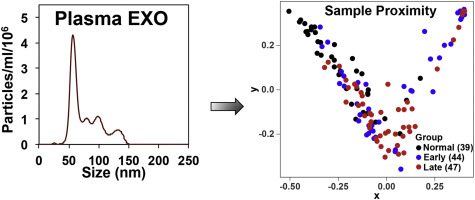当前位置:
X-MOL 学术
›
Anal. Chim. Acta
›
论文详情
Our official English website, www.x-mol.net, welcomes your feedback! (Note: you will need to create a separate account there.)
Exosomal lipids for classifying early and late stage non-small cell lung cancer
Analytica Chimica Acta ( IF 6.2 ) Pub Date : 2018-12-01 , DOI: 10.1016/j.aca.2018.02.051 Teresa W M Fan 1 , Xiaofei Zhang 2 , Chi Wang 3 , Ye Yang 1 , Woo-Young Kang 1 , Susanne Arnold 4 , Richard M Higashi 1 , Jinze Liu 2 , Andrew N Lane 1
Analytica Chimica Acta ( IF 6.2 ) Pub Date : 2018-12-01 , DOI: 10.1016/j.aca.2018.02.051 Teresa W M Fan 1 , Xiaofei Zhang 2 , Chi Wang 3 , Ye Yang 1 , Woo-Young Kang 1 , Susanne Arnold 4 , Richard M Higashi 1 , Jinze Liu 2 , Andrew N Lane 1
Affiliation

|
Lung cancer is the leading cause of cancer deaths in the United States. Patients with early stage lung cancer have the best prognosis with surgical removal of the tumor, but the disease is often asymptomatic until advanced disease develops, and there are no effective blood-based screening methods for early detection of lung cancer in at-risk populations. We have explored the lipid profiles of blood plasma exosomes using ultra high-resolution Fourier transform mass spectrometry (UHR-FTMS) for early detection of the prevalent non-small cell lung cancers (NSCLC). Exosomes are nanovehicles released by various cells and tumor tissues to elicit important biofunctions such as immune modulation and tumor development. Plasma exosomal lipid profiles were acquired from 39 normal and 91 NSCLC subjects (44 early stage and 47 late stage). We have applied two multivariate statistical methods, Random Forest (RF) and Least Absolute Shrinkage and Selection Operator (LASSO) to classify the data. For the RF method, the Gini importance of the assigned lipids was calculated to select 16 lipids with top importance. Using the LASSO method, 7 features were selected based on a grouped LASSO penalty. The Area Under the Receiver Operating Characteristic curve for early and late stage cancer versus normal subjects using the selected lipid features was 0.85 and 0.88 for RF and 0.79 and 0.77 for LASSO, respectively. These results show the value of RF and LASSO for metabolomics data-based biomarker development, which provide robust an independent classifiers with sparse data sets. Application of LASSO and Random Forests identifies lipid features that successfully distinguish early stage lung cancer patient from healthy individuals.
中文翻译:

用于分类早期和晚期非小细胞肺癌的外泌体脂质
肺癌是美国癌症死亡的主要原因。早期肺癌患者通过手术切除肿瘤可以获得最好的预后,但这种疾病往往在发展到晚期时才出现症状,而且目前还没有有效的血液筛查方法来早期发现高危人群中的肺癌。我们使用超高分辨率傅里叶变换质谱(UHR-FTMS)探索了血浆外泌体的脂质谱,以早期检测流行的非小细胞肺癌(NSCLC)。外泌体是各种细胞和肿瘤组织释放的纳米载体,可引发重要的生物功能,例如免疫调节和肿瘤发展。从 39 名正常受试者和 91 名 NSCLC 受试者(44 名早期和 47 名晚期)获得血浆外泌体脂质谱。我们应用了两种多元统计方法,随机森林(RF)和最小绝对收缩和选择算子(LASSO)来对数据进行分类。对于 RF 方法,计算指定脂质的基尼重要性,以选择最重要的 16 种脂质。使用 LASSO 方法,根据分组 LASSO 惩罚选择 7 个特征。使用选定的脂质特征,早期和晚期癌症与正常受试者的受试者工作特征曲线下面积分别为:RF 为 0.85 和 0.88,LASSO 为 0.79 和 0.77。这些结果显示了 RF 和 LASSO 对于基于代谢组学数据的生物标志物开发的价值,它们为稀疏数据集提供了稳健的独立分类器。应用 LASSO 和随机森林识别脂质特征,成功区分早期肺癌患者和健康个体。
更新日期:2018-12-01
中文翻译:

用于分类早期和晚期非小细胞肺癌的外泌体脂质
肺癌是美国癌症死亡的主要原因。早期肺癌患者通过手术切除肿瘤可以获得最好的预后,但这种疾病往往在发展到晚期时才出现症状,而且目前还没有有效的血液筛查方法来早期发现高危人群中的肺癌。我们使用超高分辨率傅里叶变换质谱(UHR-FTMS)探索了血浆外泌体的脂质谱,以早期检测流行的非小细胞肺癌(NSCLC)。外泌体是各种细胞和肿瘤组织释放的纳米载体,可引发重要的生物功能,例如免疫调节和肿瘤发展。从 39 名正常受试者和 91 名 NSCLC 受试者(44 名早期和 47 名晚期)获得血浆外泌体脂质谱。我们应用了两种多元统计方法,随机森林(RF)和最小绝对收缩和选择算子(LASSO)来对数据进行分类。对于 RF 方法,计算指定脂质的基尼重要性,以选择最重要的 16 种脂质。使用 LASSO 方法,根据分组 LASSO 惩罚选择 7 个特征。使用选定的脂质特征,早期和晚期癌症与正常受试者的受试者工作特征曲线下面积分别为:RF 为 0.85 和 0.88,LASSO 为 0.79 和 0.77。这些结果显示了 RF 和 LASSO 对于基于代谢组学数据的生物标志物开发的价值,它们为稀疏数据集提供了稳健的独立分类器。应用 LASSO 和随机森林识别脂质特征,成功区分早期肺癌患者和健康个体。



























 京公网安备 11010802027423号
京公网安备 11010802027423号